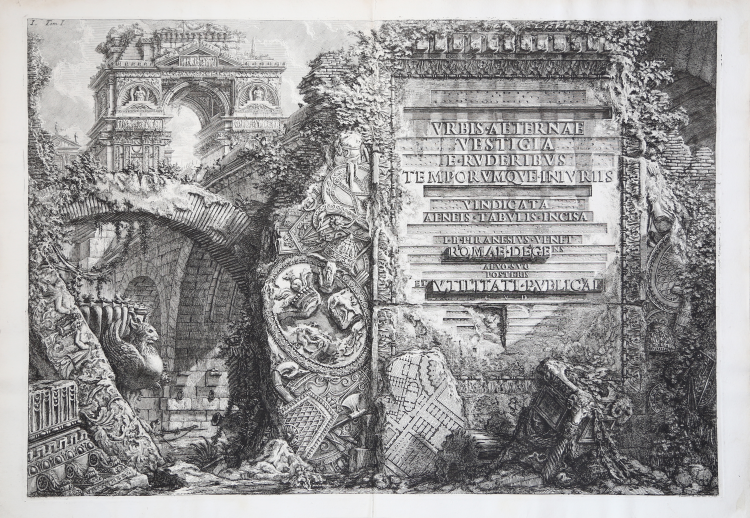




| Reference: | S50139 |
| Author | Giovan Battista PIRANESI |
| Year: | 1756 |
| Measures: | 680 x 465 mm |



| Reference: | S50139 |
| Author | Giovan Battista PIRANESI |
| Year: | 1756 |
| Measures: | 680 x 465 mm |
Top right: I. Tom. I.; lower left: Piranesi Archit. inv. and sculpt. Center of plaque: VRBIS-ÆTERNÆ-VESTIGIA / E RVDERIBVS TEMPORVMQVE INIVRIIS VINDICATA - ÆNEIS- TABVLIS-INCISA / I B PIRNAESI VENET ROMAE DEGENS AEVO SVO / POSTERIS / ET VTILITATI PUBLICAE.
Etching and enrgaving, ca. 1756, signed in plate at lower right. Example in the third state of four with the dedication utilitati publicae.
The plate was engraved by Piranesi for the frontispiece of the first tome of Le Antichità Romane. The intriguing composition features redundant architectural and sculptural fragments from the ancient factories of Rome, some recognizable, such as the fluted cup with feet in the form of griffins from Villa Albani, for which the engraver also reserved a plate in the first volume of Vasi, candelabri, cippi, published in 1778; others, such as the reliefs with stacks of arms and the frieze with phytomorphic figures and candelabra, in the lower left corner, inspired respectively by the reliefs of the base of Trajan's column and the decorative friezes of the Domus Flavia brought to light-the latter by excavations conducted by Francesco Bianchini on the Palatine in the 1720s.
The image summarizes the project of the whole work and expresses, on an ideal and fantastic plane, the original Piranesian antiquarian taste, at once philologically documented, critically and stylistically autonomous.
The matrix denounces extensive abrasions, of which the most considerable are related to the changes of state that occurred to modify the dedication of the Antiquities initially addressed to Jacopo Caulfield. Of the print we know four states. The first with the dedication inscribed on the large plaque occupying the right half of the composition, “NOBILISSIMO VIRO / VTILITATI PVBLICAE NATO / IACOBO CAVLFIELD/ ... ”, and with Caulfield's arms in the oval in the center; the second state in which Piranesi, having fired about sixty specimens with the nobleman's name, limited himself to the elimination of the first nine lines of the dedicatory inscription, i.e., those strictly referring to Caulfield, and the last two lines of the text “LVBENS DEVOTUSQUE / DEDICAVIT” depicting chiseling on the tombstone, and abrading the central part of the coat of arms; the third state in which, at a slightly later stage, Piranesi thought of addressing the work “AEVO SVO / POSTERIS / ET VTILITATI PUBLICAE” with the incipit of the dedication “VRBIS AETERNAE / VESTIGIA” and depicting the fractured coat of arms. Finally, the fourth state coinciding with the matrix, relating to the second edition of the Antichità Romane of 1784, edited by his son Francesco, with the dedication to Gustavus III King of Sweden in the plaque and the sovereign's coat of arms in the oval, instead of Caulfield's.
Magnificent proof, printed on contemporary laid paper with watermark “double circle and fleur-de-lis with letters CB” (Robison 33), typical of the 1756 edition of Antichità Romane. Usual central vertical crease, full margins, in excellent condition.
Bibliografia
Petrucci, 1953, tav. 2, p. 241; Focillon, 1967, n. 144, p. 300; Ficacci, 2000, n. 139, p. 169; Wilton Ely 279.
Giovan Battista PIRANESI (Mogliano Veneto 1720 - Roma 1778)
|
Italian etcher, engraver, designer, architect, archaeologist and theorist. He is considered one of the supreme exponents of topographical engraving, but his lifelong preoccupation with architecture was fundamental to his art. Although few of his architectural designs were executed, he had a seminal influence on European Neo-classicism through personal contacts with architects, patrons and visiting artists in Rome over the course of nearly four decades. His prolific output of etched plates, which combined remarkable flights of imagination with a strongly practical understanding of ancient Roman technology, fostered a new and lasting perception of antiquity. He was also a designer of festival structures and stage sets, interior decoration and furniture, as well as a restorer of antiquities. The interaction of this rare combination of activities led him to highly original concepts of design, which were advocated in a body of influential theoretical writings. The ultimate legacy of his unique vision of Roman civilization was an imaginative interpretation and re-creation of the past, which inspired writers and poets as much as artists and designers.
|
Giovan Battista PIRANESI (Mogliano Veneto 1720 - Roma 1778)
|
Italian etcher, engraver, designer, architect, archaeologist and theorist. He is considered one of the supreme exponents of topographical engraving, but his lifelong preoccupation with architecture was fundamental to his art. Although few of his architectural designs were executed, he had a seminal influence on European Neo-classicism through personal contacts with architects, patrons and visiting artists in Rome over the course of nearly four decades. His prolific output of etched plates, which combined remarkable flights of imagination with a strongly practical understanding of ancient Roman technology, fostered a new and lasting perception of antiquity. He was also a designer of festival structures and stage sets, interior decoration and furniture, as well as a restorer of antiquities. The interaction of this rare combination of activities led him to highly original concepts of design, which were advocated in a body of influential theoretical writings. The ultimate legacy of his unique vision of Roman civilization was an imaginative interpretation and re-creation of the past, which inspired writers and poets as much as artists and designers.
|